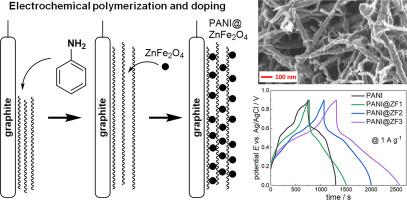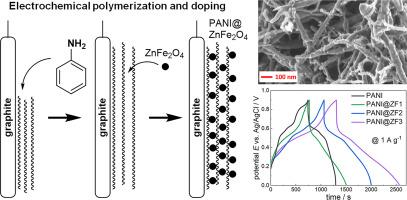电化学合成PANI-ZnFe2O4电极的储能性能和循环稳定性研究
IF 5.6
3区 材料科学
Q1 ELECTROCHEMISTRY
引用次数: 0
摘要
导电聚合物-金属氧化物杂化材料是超级电容器极具前景的电极材料,但如何在高电容和长期稳定性之间取得平衡仍然具有挑战性。本文采用苯胺原位电化学聚合的方法合成了聚苯胺(PANI) -铁酸锌(ZnFe₂O₄)复合材料,并控制沉积时间。结构和光谱表征证实了ZnFe2O4在聚合物基体内均匀分散,并形成了纤维状纳米结构。电化学分析表明,随着ZnFe2O4含量的增加,氧化还原活性和电荷存储能力逐渐增强。优化后的复合材料的比容高达1402 F g⁻¹,能量密度为141.9 Wh kg⁻¹,功率密度为404.9 W kg⁻¹。当组装成对称超级电容器时,聚苯胺-锌铁氧体复合材料在10,000次充放电循环后保持了97.6%的初始电容。电化学阻抗谱进一步表明,加速老化下的结构降解主要与颗粒和聚合物链的开裂/断裂有关,导致质量传递阻力增加,从而降低了储能能力。本文章由计算机程序翻译,如有差异,请以英文原文为准。


Investigation of energy storage performance and cycling stability of electrochemically synthesized PANI–ZnFe2O4 electrodes
Conducting polymer-metal oxide hybrids are promising electrode materials for supercapacitors, yet achieving a balance between high capacitance and long-term stability remains challenging. In this work, polyaniline (PANI) - zinc ferrite (ZnFe₂O₄) composites were synthesized by in situ electrochemical polymerization of aniline with controlled deposition duration for ZnFe2O4-nanoparticle incorporation. Structural and spectroscopic characterization confirmed uniform dispersion of ZnFe2O4 within the polymer matrix and the formation of fibrous nanostructures. Electrochemical analysis revealed a progressive enhancement of redox activity and charge storage with increasing ZnFe2O4 content. The optimized composite exhibited a specific capacitance of up to 1402 F g⁻¹ at 1 A g⁻¹, together with an energy density of 141.9 Wh kg⁻¹ and a power density of 404.9 W kg⁻¹. When assembled into a symmetric supercapacitor, the PANI-zinc ferrite composite retained 97.6 % of its initial capacitance after 10,000 charge–discharge cycles. Electrochemical impedance spectroscopy further indicated that structural degradation under accelerated aging is primarily associated with particle and polymer chain cracking/breaking, leading to increased mass transport resistance, thereby reducing the energy storage capability.
求助全文
通过发布文献求助,成功后即可免费获取论文全文。
去求助
来源期刊

Electrochimica Acta
工程技术-电化学
CiteScore
11.30
自引率
6.10%
发文量
1634
审稿时长
41 days
期刊介绍:
Electrochimica Acta is an international journal. It is intended for the publication of both original work and reviews in the field of electrochemistry. Electrochemistry should be interpreted to mean any of the research fields covered by the Divisions of the International Society of Electrochemistry listed below, as well as emerging scientific domains covered by ISE New Topics Committee.
 求助内容:
求助内容: 应助结果提醒方式:
应助结果提醒方式:


